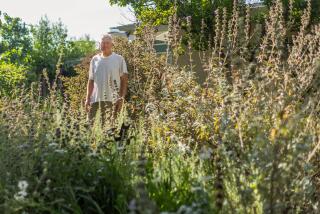It Takes Real Spine to Join This House
- Share via
In the plant world, cactuses are like the geeky teenagers who dress funny and have a hard time attracting dates. But get to know them over time, years even, and they can blossom -- literally.
Cactus converts in Southern California can get their fix at a Stanton store that doubles as a bungalow-sized shrine to the spiny succulents. Tucked between a closed taco stand and a medical building on Beach Boulevard, the House of Cactus lodges more than 1,500 kinds of cactuses.
The store can be sweltering, especially in the half that is enclosed in fiberglass. The other half is in the open. But even during a May heat wave, several customers wandered through the dozen or so gravel-covered aisles, tucking their purchases into cardboard boxes.
A cactus collection this large in a store this small means that most of the plants can fit in one’s hand, such as the rust-brown pods about the size of a cat’s paw and the green stalk clusters nicknamed “Baby Toes.”
The price range is vast, making it easy to begin a collection of the low-maintenance plants. Many cost less than $10, although some of the more mature ones cost hundreds of dollars, because of the time it can take succulents to grow. Many types grow up and out by less than an inch per year.
Guiding visitors through their selections is Nancy Hipp, who bought the store in 1976 with her now-deceased husband, Richard. Before that, the store operated for nearly 20 years as Black’s House of Cactus, named after the original owners.
Hipp’s interest in gardening began early; as a child, she planted the tops of pineapples and carrots in her backyard to see if they would sprout. She and her husband grew to love cactuses while living in San Diego and visiting the store when the Blacks owned it.
“To us they were so sculptural,” she said. “When they’re all jammed together, you don’t see it, but so many of them have such intriguing shapes.”
She tries not to play favorites among her cactuses, she says, but gravitates toward those that grow best in the shade, including hoya, which has waxy white flowers. At home, she has hung plants with leaves that dangle five feet over the edge of their pots. The cactuses also form a halo of greenery above the cash register, creating the store’s only slice of shade.
Hipp, a soft-spoken woman with piercing blue eyes, has run the store alone since her husband died of cancer almost four years ago. Before that she worked as a dietitian, spending her evenings and weekends at the store.
Richard Hipp would work alongside his parrots, including Mikey. The bird would sit on the gate at the front of the store, greeting customers with a squawking admonishment: “Buy a cactus!” The bird is buried under the gate; a small plastic statue of St. Francis of Assisi watches over him.
Nancy Hipp says she keeps the store open as a tribute to her cactus-obsessed husband, and the job keeps her too busy to dwell on her grief. She knows she’ll someday sell the store, which is open on Thursday and Friday afternoons and on the weekends.
With the shortened hours, she is busy advising customers about developing their collections or caring for their selections. Ed and Joan Darnbrough brought in snapshots of their new Mission Viejo home, its pool already framed by a dozen cactuses.
They took home a 2-foot spiky stalk to plant in a corner of their yard along with a smaller cactus bearing lemon-yellow flowers.
Their nephew, a landscaper, told them about the House of Cactus.
“It’s a rare jewel in this county,” Ed Darnbrough, 69, said. “We’ll be back.”
Other customers are drawn to cactuses’ distinctive form. Erin Cornelison, 45, of Norwalk has collected almost 100 cactuses and left the Stanton store on a recent weekend with four more.
“I love how cactuses can look so awkward. It’s unusual stuff. Weird stuff,” she said. “It’s not ordinary.”
In the cactus world, the more each plant is different, the better. One variety that resembles a saguaro plant with grotesquely twisted arms fetches $375.
Others look like green brains, fuzzy yellow wishbones or the rounded spikes on a triceratops’ head.
A spiny cucumber-sized stalk covered with stringy white hair bears an uncanny resemblance to Cousin It from the television show “The Addams Family.” In the species’ native Hidalgo, Mexico, the hair is a protection from the sun.
Some succulents are more conventionally attractive, such as those with curly-edged leaves that look like purple cabbage or the round prickly balls that flower with spectacular blooms in shades of banana and scarlet.
A few possess an appeal that could be lost on most people. Hanging from overhead beams are several pots of what look like sticks drooping over the sides.
“You have to be a really die-hard collector to see the beauty in these,” Hipp said, reaching up to stroke the brown tendrils, so dry they crackle at her touch. “To me, if they grow, they’re wonderful.”
Hipp’s arms show the pinpoint scabs that are the occupational hazard of potting and carrying cactuses.
But she doesn’t mind, preferring to think of the pricks as scratches from a cat: “Neither of them know any better.
“Other people pay for acupuncture,” she quipped. “I get it free.”
More to Read
Sign up for The Wild
We’ll help you find the best places to hike, bike and run, as well as the perfect silent spots for meditation and yoga.
You may occasionally receive promotional content from the Los Angeles Times.






